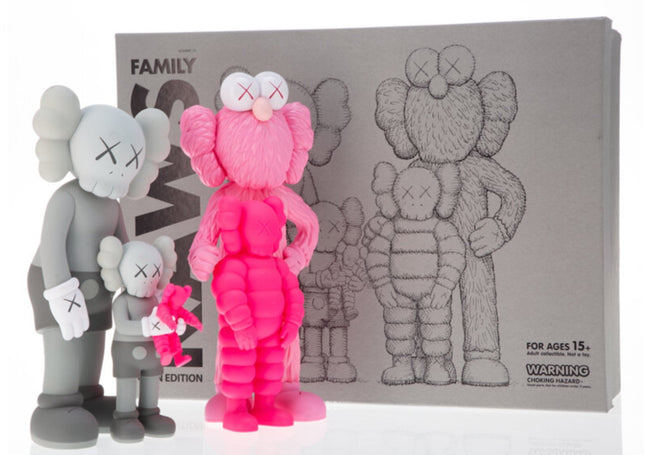
Gray/Grey
-

Kaws- Brian Donnelly Family- Grey/Pink Fine Art Toy by Kaws- Brian Donnelly
Family- Grey/Pink Limited Edition Vinyl Art Toy Collectible Artwork by Modern Pop Artist Kaws. 2021 Limited Open Edition 13.39 X 12.2 X 5.71 IN / 34 X 31 X 14.5 CM Displayed With Box. KAWS' Family-Grey/Pink Series and Its Place in Street Pop Art The "Family-Grey/Pink" Limited Edition Vinyl Art Toy Collectible set by KAWS, unveiled in September 2021, epitomizes the fusion of street culture with high-end collectible art. As part of his acclaimed TOKYO FIRST art exhibit in Japan, the release includes a compelling combination of two Companion figures, a mini and full-sized Chum figure, and a striking BFF figure. Each piece in this 13.39 x 12.2 x 5.71-inch set is presented with meticulous attention to detail that KAWS is renowned for, displayed with its original box, enhancing its aesthetic presentation and collectible value. The assortment of grey and pink hues offers a visually arresting contrast, bringing a dynamic vibrancy to the collection. These colors, chosen by KAWS, are not arbitrary; grey often symbolizes balance and neutrality in art, while pink can represent playfulness and warmth, reflecting the diverse emotions and relationships encapsulated within the concept of family. By applying these colors to his iconic characters, KAWS invites a dialogue on the varying dynamics within familial bonds as interpreted through the lens of Street Pop Art and graffiti Artwork. Cultural Resonance of KAWS' Art in the Contemporary Scene In the landscape of contemporary art, KAWS' "Family-Grey/Pink" series stands out as a significant work that captures the zeitgeist of modern Street Pop Art and graffiti Artwork. The set's release at the TOKYO FIRST exhibit is a testament to the broad appeal and profound impact of KAWS' art. His ability to translate street art's raw energy and ethos into collectible figures has allowed his work to transcend traditional art spaces and connect with a global audience. The series' playful yet thoughtful depiction of the characters, characterized by their crossed-out eyes—a signature artist motif—challenges the viewers to find deeper meanings behind the seemingly simple exteriors. Therefore, this set is not only a representation of KAWS' artistic talent but also an embodiment of the themes prevalent in street art, such as community, identity, and the human experience, rendered with a finesse unique to his artistic language. KAWS' Impact on the Evolution of Street Art and Collectibles The impact of the "Family-Grey/Pink" collection on the evolution of street art is multifaceted. By elevating the art toy to the status of a collectible item, KAWS has played a pivotal role in the commodification of street art, ensuring its accessibility and engagement with a broader public. The limited open edition nature of the series aligns with street art's inherent democratic spirit, offering art enthusiasts and collectors the opportunity to own a piece of this cultural phenomenon. Moreover, the series' September 2021 release reflects the growing trend of integrating art with lifestyle, where holding a KAWS figure is as much about aesthetic appreciation as it is about making a statement of cultural awareness. Therefore, the "Family-Grey/Pink" set is not just a cluster of figures but a curated selection of art that speaks to the heart of street culture, inviting reflection, discussion, and appreciation of Street Pop Art and graffiti Artwork in contemporary times.
$1,968.00


